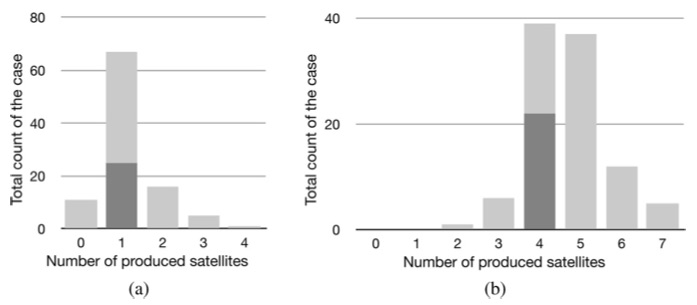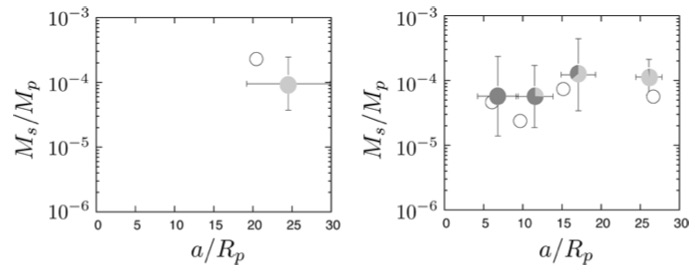The Jovian satellite system mainly consists of four Galilean satellites, where the inner two satellites are rocky and outer two are icy, and only the outermost one is compositionally undifferentiated. They have similar masses and are trapped in mutual mean motion resonances. On the other hand, the Saturnian satellite system has only one big icy body, Titan, and the other satellites have masses that are two orders of magnitude smaller. Since both satellite systems would have been produced in similar circum-planetary proto-satellite disks, the origin of the diversity has been a long-standing question.
We explained the origin of the diversity by simulating growth and orbital evolution of proto-satellites in an accreting proto-satellite disk model that is combined with the idea of different termination timescales of gas infall between Jupiter and Saturn based on a planet formation model.
The results of produced satellites from 100 runs for each of Saturnian and Jovian systems are depicted in figures below.

Distribution of the number of final surviving satellites with M > 10−5 Mp produced from 100 simulations for each system, (a) Saturnian system and (b) Jovian system. Dark gray parts show the runs that the produced satellite systems are analogous to the real one: for the Saturnian system, the largest satellite is icy and M > 10−4 Mp, while for the Jovian system, the inner two bodies are rocky and the outer two are icy satellites.
Theoretically predicted satellite systems. For the Saturnian case, the average mass (Ms)and semimajor axis (a) of the largest satellites with their standard deviations are plotted with filled circles with bars for the highest probability cases (67 runs among 100 runs) in which only one large satellite (Ms > 10−5 Mp) is produced. The open circle represents Titan. For the Jovian case, the averaged mass-semimajor axis and their standard deviations from the highest probability runs (39 runs) that produced four large satellites are plotted. Galilean satellites are represented by open circles. The colors of each plot show the average fraction of rocky (dark gray) and icy (light gray) components of the formed satellites.
In the case of the Jovian system, a few similar-mass satellites are likely to remain in mean motion resonances, the configuration of which is formed by type I migration, temporal stopping of the migration near the disk inner edge, and quick truncation of gas infall by gap opening in the Solar nebula.
The Saturnian system tends to end up with one dominant body in the outer regions caused by the slower decay of gas infall associated with global depletion of the Solar nebula. The compositional zoning of the predicted satellite systems is consistent with the observed satellite systems.
Our results indicate that the diversity of the satellite systems is closely related to how the final masses of gas giant planets are determined, which is a big debate in the context of the mass distribution and multiplicity of extrasolar gas giants. The architecture of the Galilean satellites may be fossil evidence that Jupiter opened up a clear gap in the circum-stellar proto-planetary disk to terminate its growth.

Be the first to comment